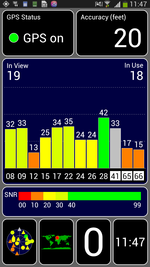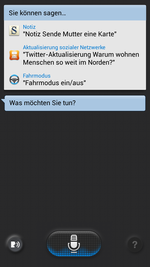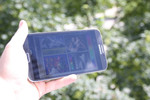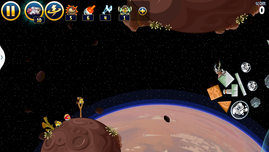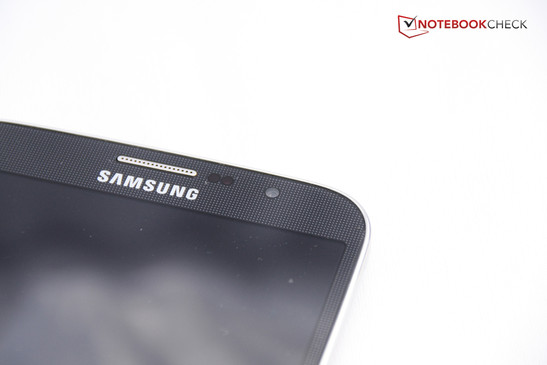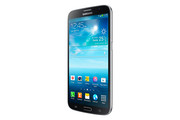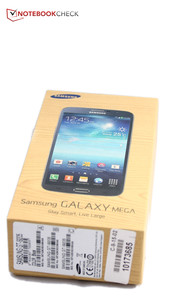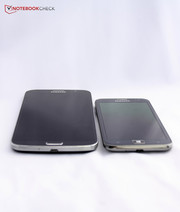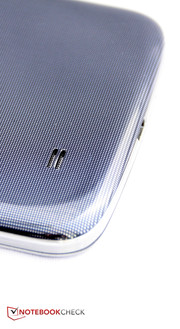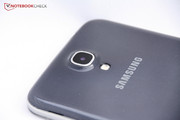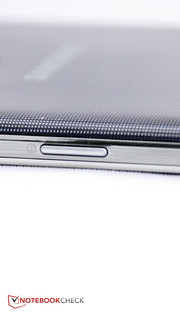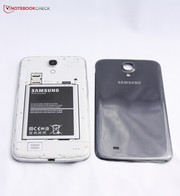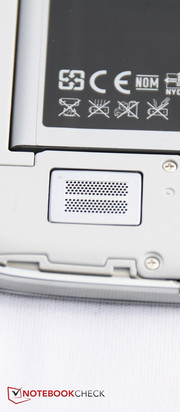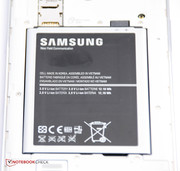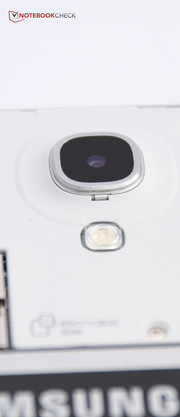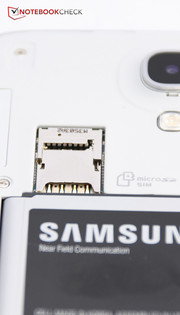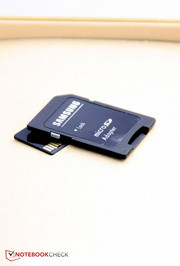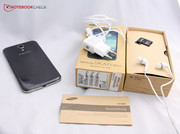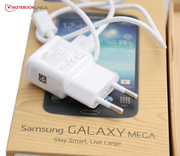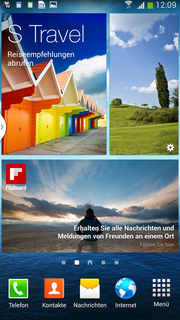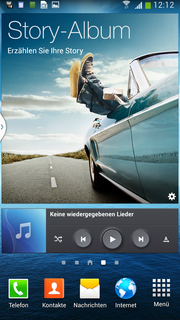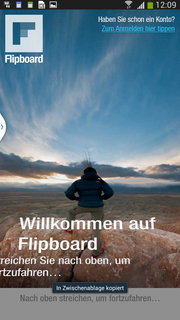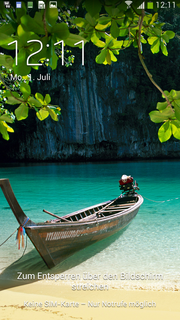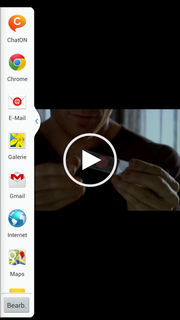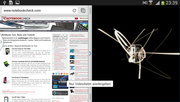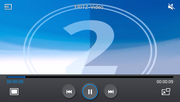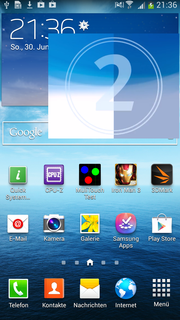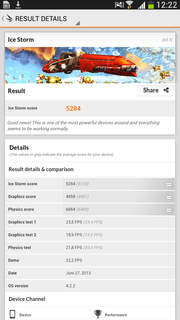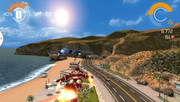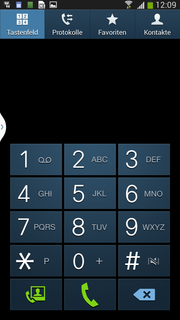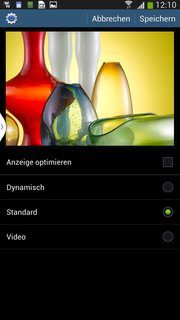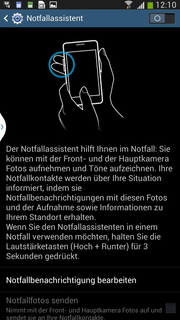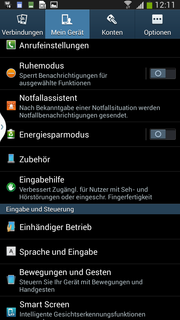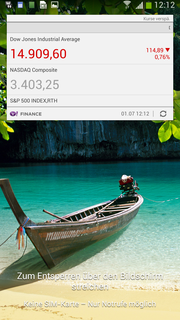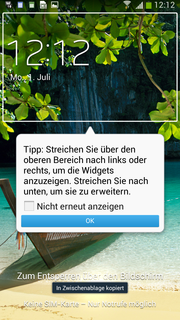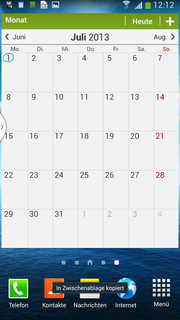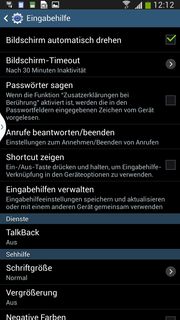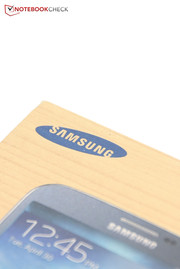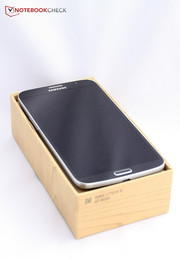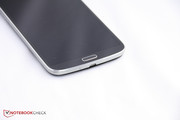Review Samsung Galaxy Mega 6.3 I9200 Smartphone

For the original German review, see here.
"Phablet" seems to be a buzzword right now: the devices, which are slotted between smartphones and tablets as far as their size is concerned, feature - at least for smartphones - a huge display, but also offer phone functionality. Despite the size, larger jeans pockets still provide enough space for these hybrids (called "smartlets" in Germany). The Samsung Galaxy Mega is one of the largest phablets available - the 6.3-inch display is almost as large as the displays found on 7-inch tablets. To ensure that the Mega still fits into pockets, Samsung uses a display with a 16:9 aspect ratio.
An RRP of 599 Euros (~$770) isn't exactly a bargain - the Galaxy Mega is priced at the upper end of middle-class phones. For a little more, potential buyers can get their hands on high-end smartphones like the Samsung Galaxy S4, the HTC One, or Sony's Xperia Z and Xperia ZL. The LG Optimus G, Google Nexus 4, iPhone 5, and the Samsung Ativ S are other options. The Huawei Ascend Mate also comes with a large display, but costs less. Samsung's own Galaxy Note series also competes with the Galaxy Mega. Users looking for a combination of the best features from both smartphones and tablets might also find the Asus PadFone 2 a compelling alternative.
There are plenty of choices - let's see how the Samsung Galaxy Mega fares against the competition.
Case
"Wow - that's big!" - that's the initial reaction from other editors and casual observers alike when they see the extra-large smartphone for the first time. Fortunately, the Galaxy Mega, which measures 18.8 x 8.8 x 0.8 centimeters, still fits in many pockets - although those who favor skinny jeans might be out of luck.
Users familiar with the Samsung Galaxy S4 won't need a long time to adjust: with the Galaxy Mega, Samsung continues the tradition of taking the case of the top-of-the-line Galaxy S and resizing it to fit other phones. While this strategy has worked well for Samsung in the past and the build quality is up to the usual high standards, the large display does impact the sturdiness of the design: when we applied pressure from the back, the screen showed some ripples - and we were able to bend the case fairly easily when grabbing the corners.
For some, the choice of plastic as the main material for this upper-class phone might still be a deal breaker - but the Galaxy Mega certainly doesn't feel cheap and the weight is also pleasantly light at 199 grams. Our review model is black, although Samsung also offers a version dressed in white. The back of the phablet features tiny reflective squares on top of the black paint. Beauty is in the eye of the beholder - it's up to the user to decide if they think the design is sophisticated or tacky. We admit that we would have preferred a matte surface instead.
Connectivity
The Galaxy Mega - outfitted with a dual-core processor and the standard micro-USB port on the bottom and audio jack on the top - is equipped similarly to its upper middle-class competitors. Only the 1.5 GB of RAM is a distinguishing factor: the iPhone 5 comes with 1 GB - the Samsung Galaxy S4 and most higher-end phones come with 2 GB. The flash storage space of only 8 GB is also an indicator that Samsung's Galaxy Mega is more of a middle-class and not high-end phablet.
Software
The Samsung Galaxy Mega uses the same software - Android 4.2.2 - as the high-end Galaxy S4. Samsung applies its own TouchWiz interface on top of the operating system. As far as the operation is concerned, changes are minimal though - so users of other Android systems won't need long to adapt.
Additional preinstalled software also mirrors the Galaxy S4: "S Voice" is a comprehensive voice control software package similar to Apple's Siri. "S Planner" is a powerful calendar tool, "WatchON" allows the Galaxy Mega to be used as a remote control, and "Story Album" allows the user to create photo albums with text and graphics, which can then be displayed on the home screen.
Although we like that Samsung includes plenty of software, we think that the "Samsung Apps" are a rather unnecessary addition, since the software requires the user to have a Samsung account just to access Google Play via a secondary route. At least there's hardly any bloatware - the German version of the phablet neither includes the tabloid paper nor the hotel broker software which was preinstalled on the Galaxy S4.
Communication & GPS
Thanks to quad-band, quad-band UMTS, and hexa-band LTE support, the Galaxy Mega should be able to handle all cellular phone networks around the globe. Unlike the Galaxy S4, the Galaxy Mega doesn't support the latest WLAN standard 802.11 ac - since there are hardly any routers at this time, this shouldn't matter too much. The phablet supports WLAN standards 802.11 a/b/g/n and also features NFC and Bluetooth 4.0. Our reception test showed decent, but not outstanding performance: ten meters from the router and through three walls we recorded between three-quarters and one-half of the full signal strength. Adding another wall drops the signal strength to about 50%. Other smartphones and tablets feature better Wi-Fi reception.
The satellite module supports GPS as well as the Russian Glonass network. The reception quality is quite good: the position is established to within a few meters after just a few seconds. Impressive: the GPS works quite well inside, although not quite as accurate.
Telephony
The phone app is equivalent to the one we are used to from the Samsung Galaxy S4; the voice quality is also very good: the voice of the caller was loud and clear and easy to understand on our end and vice versa. The reception quality - our provider is German Telekom - is actually slightly better on the Galaxy Mega: while the Galaxy S4 didn't always show all bars, the new phablet did.
Cameras & Multimedia
The cameras are also worthy of an upscale device: the 8 megapixel camera on the back takes (daylight) photos which are equivalent in quality to the iPhone 5 or the Galaxy S4. One of the strengths of the Nokia Lumia 920 is low-light conditions - when the light is bright and exposure times are long, the pictures tend to be brighter than normal and suffer from camera shake more easily. For that reason, photos taken with the Samsung Galaxy Mega look sharper than ones taken with Nokia's high-end phone. The Galaxy Mega does suffer from very high color noise in low-light conditions - but the LED flash does improve the quality in these scenarios. All in all, the quality is quite impressive - especially since the 1.9 megapixel camera up front is also capable of decent pictures.
Videos can be played back using the integrated player; it's also easy to access other devices within the same network and download videos from there. Once the videos are saved on the Galaxy Mega, the player-window can be positioned so it floats above the navigation screen: that way, other tasks can be accomplished while the video is playing. The playback of saved HD videos also worked without a hitch.
Accessories
Samsung doesn't skimp on accessories: aside from the quick-start guide and the power adapter with detachable USB cable, the box also includes a headset and a 4 GB microSD card with adapter.
At the time of writing, Samsung's online shop didn't offer any accessories for the Galaxy Mega. Many different add-ons are available for the Samsung Galaxy S4 - but due to missing software or because of the form factor, those accessories are not compatible with the Galaxy Mega. The menu does offer settings for a universal USB docking station.
Warranty
In some countries, the Galaxy Mega is - like many other Samsung smartphones - covered for a period of 24 months. To take advantage of the warranty, the phone needs to be shipped to or dropped off at an authorized service center.
Input Devices & Operation
The Galaxy Mega and the Samsung Galaxy S4 also have striking similarities here: while the keys are slightly smaller, the number keys are now directly accessible. Since the display is so large, it's quite easy to work with the virtual keyboard, which can be configured and adapted extensively - for example, it's possible to swipe the keys instead of pressing them. In addition, the Galaxy Mega also supports voice and handwriting recognition. All input choices work flawlessly. A little highlight: the keyboard can be detached and moved across the screen. Users who don't like the above choices can also opt for the classic Android keyboard.
The capacitive touchscreen recognizes up to 10 fingers at the same time. The surface allows fingers to glide easily and input is supported all the way into the corners. An advantage of the large display: the very large icons.
Other modes of operation
The Galaxy Mega features almost all the innovative control methods of the Galaxy S4 like "simple mode", which simplifies the home screen, eye recognition, voice control, aids for people with disabilities, Air-View, and a whole lot more. Only scrolling with the eyes is not supported. Since these methods function much like on the Galaxy S4, we urge our readers to check out the review of Samsung's high-end smartphone.
We like the fact that Samsung offers the user so many different ways of modifying the operation of the Galaxy Mega to their liking - although all those options might confuse new users. Samsung also offers many accessibility options for users with disabilities: the camera light can be set to turn on when a message is received, the user can enable magnification, invert screen colors, and tweak many other settings.
Display
No Full HD, no AMOLED display - the Galaxy Mega doesn't copy all the features of the Samsung Galaxy S4. The resolution is only 1280x720 pixels - quite a bit less than the Full HD resolution of the high-end smartphone. Since the display is so large, the difference would be noticeable. Although all icons are sharp and individual pixels are not discernible with the naked eye, a Full HD display would have been the better choice. However, the Huawei Ascend Mate has the same-size screen and also comes with 720p resolution.
The display is based on LCD technology, which can produce really nice screens - see for example the HTC One. The average brightness is very high at 443.7 cd/m² - although most high-end smartphones can at least equal this value if not better it. The Samsung Galaxy S4 doesn't get quite as bright due to the AMOLED technology.
| |||||||||||||||||||||||||
Brightness Distribution: 90 %
Center on Battery: 477 cd/m²
Contrast: 1060:1 (Black: 0.45 cd/m²)
ΔE ColorChecker Calman: 4.4 | ∀{0.5-29.43 Ø4.79}
ΔE Greyscale Calman: 3.4 | ∀{0.09-98 Ø5}
Gamma: 2.23
CCT: 7181 K
We measured a contrast ratio of 1060:1 - good, but far below the HTC One, which almost doubles this value. The black value of 0.45 cd/m² is fairly average. Blacks appear pretty saturated, although they can look dark gray at times depending on the brightness level. Although Samsung's AMOLED displays are known for their extraordinary colors, the Galaxy Mega is no slouch and the colors are saturated and vivid.
Just like with the Galaxy S4, the user can choose different display modes. "Dynamic" has very vivid colors, "Standard" has normal saturation and contrast, and "Video" offers a natural, albeit not very saturated picture. The Galaxy Mega also features an automatic mode, which chooses the display mode without user input.
Color accuracy is - according to our test with CalMAN software and a colorimeter - quite good with the phablet in "Video" mode. Even when using "Dynamic" mode, the deviation of the colors from their sRGB ideals is pretty moderate. Lighter grays deviate the most from their ideal values - "Video" mode is also the best choice here. Even when using the much larger AdobeRGB color space for comparison, the average DeltaE of 4.04 for many of the colors is certainly acceptable.
Due to the high screen brightness, the Galaxy Mega can be used outside even on very bright days. Even when exposed to direct sunlight, the screen content remains decipherable - although it's very tiring for the eyes in the long run. Inside, the brightness has to be decreased especially when there's a lot of white in the picture - otherwise the screen can be blinding.
Performance
The dual-core SoC is sourced from Snapdragon and is clocked at 1.7 GHz. The Galaxy Mega features 1.5 GB of RAM. Most high-end smartphones usually feature quad-core processors and more RAM. Our review model does come with a processor with a higher clock speed than the Huawei Ascend Mate.
As far as the processor performance is concerned, the Samsung device outperforms the Huawei Ascend Mate when running synthetic benchmark tests. Overall, the Galaxy Mega offers lower middle-class performance when compared to the competition. We were still able to navigate smoothly however - even when running two applications simultaneously in multi-window mode.
| PassMark PerformanceTest Mobile V1 - System (sort by value) | |
| Samsung Galaxy Mega 6.3 I9200 | |
| Apple iPhone 5 | |
| Samsung Galaxy S4 GT-I9505 | |
| Google Nexus 4 | |
| Huawei Ascend Mate | |
| AnTuTu v3 - Total Score (sort by value) | |
| Samsung Galaxy Mega 6.3 I9200 | |
| Samsung Galaxy S4 GT-I9505 | |
| HTC One | |
| Sony Xperia Z | |
| Sony Xperia ZL | |
| LG Optimus G E975 | |
| Google Nexus 4 | |
| Huawei Ascend Mate | |
| Quadrant Standard Edition 2.0 - --- (sort by value) | |
| Samsung Galaxy Mega 6.3 I9200 | |
| Samsung Galaxy S4 GT-I9505 | |
| HTC One | |
| Sony Xperia Z | |
| Sony Xperia ZL | |
| Google Nexus 4 | |
| Huawei Ascend Mate | |
| Asus Padfone 2 | |
The Qualcomm Adreno 305 GPU can't quite keep up when running most of the synthetic 3D benchmark tests. Only the Huawei Ascend Mate is slower at times - but current high-end smartphones and the Asus PadFone 2 are able to outperform the Galaxy Mega decisively.
| 3DMark - 1280x720 Ice Storm Standard Score (sort by value) | |
| Samsung Galaxy Mega 6.3 I9200 | |
| Apple iPhone 5 | |
| Samsung Galaxy S4 GT-I9505 | |
| HTC One | |
| Sony Xperia ZL | |
| LG Optimus G E975 | |
| Google Nexus 4 | |
| Huawei Ascend Mate | |
| Basemark ES 2.0 - Taiji Free (sort by value) | |
| Samsung Galaxy Mega 6.3 I9200 | |
| Samsung Galaxy S4 GT-I9505 | |
| HTC One | |
| Sony Xperia Z | |
| Sony Xperia ZL | |
| LG Optimus G E975 | |
| Google Nexus 4 | |
| Huawei Ascend Mate | |
| Asus Padfone 2 | |
One might think that the just average benchmark results would negatively impact web browsing speeds - but the opposite is the case: the Galaxy Mega even outperforms the Samsung Galaxy S4 - although only by a little bit. Webpages open quickly and browsing the internet is speedy - overall an impressive performance.
| Peacekeeper - --- (sort by value) | |
| Samsung Galaxy Mega 6.3 I9200 | |
| Apple iPhone 5 | |
| Samsung Galaxy S4 GT-I9505 | |
| HTC One | |
| Sony Xperia Z | |
| Sony Xperia ZL | |
| LG Optimus G E975 | |
| Google Nexus 4 | |
| Huawei Ascend Mate | |
| Sunspider - 1.0 Total Score (sort by value) | |
| Samsung Galaxy Mega 6.3 I9200 | |
| Nokia Lumia 920 | |
| Apple iPhone 5 | |
| Samsung Galaxy S4 GT-I9505 | |
| Google Nexus 4 | |
| Huawei Ascend Mate | |
| Octane V1 - Total Score (sort by value) | |
| Samsung Galaxy Mega 6.3 I9200 | |
| Apple iPhone 5 | |
| Samsung Galaxy S4 GT-I9505 | |
| HTC One | |
| Sony Xperia Z | |
| Sony Xperia ZL | |
| LG Optimus G E975 | |
| Google Nexus 4 | |
| Huawei Ascend Mate | |
| Mozilla Kraken 1.0 - Total (sort by value) | |
| Samsung Galaxy Mega 6.3 I9200 | |
| Apple iPhone 5 | |
| Samsung Galaxy S4 GT-I9505 | |
| HTC One | |
| Sony Xperia Z | |
| Sony Xperia ZL | |
| LG Optimus G E975 | |
| Google Nexus 4 | |
| Huawei Ascend Mate | |
* ... smaller is better
It appears that Samsung not only skimped on the capacity of the internal flash storage, but also on its performance: the 8 GB module is far from speedy. Read performance is still fairly reasonable - but competing smartphones write data up to three times faster than the Galaxy Mega.
Gaming Performance
Playing games is of course a lot of fun because of the very large screen. Both the touchscreen and the position sensor allow for precise control of games. The performance is enough to play most games smoothly - at least the casual ones like Angry Birds: Star Wars or action games like Zombiewood. More demanding 3D games like Iron Man 3 are accompanied by micro-stutters. Although those don't really have a major impact, they still might delay some inputs by a fraction of a second. Although the benchmark tests clearly indicate that the Galaxy Mega lags behind the top phones as far as performance is concerned, only very few and very demanding 3D games are going to pose any limitations.
Overall gaming performance lags behind the high-end smartphones. The phablets Huawei Ascend Mate and Asus PadFone 2 perform at about the same level. Navigation is smooth, internet performance is very satisfying, and most games run without problems. Users demanding top gaming performance need to look elsewhere though.
Emissions
Temperature
The Samsung Galaxy Mega does better in this category than the Huawei Ascend Mate, which gets quite warm at times. The Galaxy Mega also heats up when it's under full load - but we measured a maximum of 39.9 °C, which might be noticeable, but is absolutely no reason for concern. During idle, our review phablet remained quite cool at a maximum of 33.9 °C.
(+) The maximum temperature on the upper side is 39.9 °C / 104 F, compared to the average of 35.2 °C / 95 F, ranging from 21.9 to 247 °C for the class Smartphone.
(+) The bottom heats up to a maximum of 39.4 °C / 103 F, compared to the average of 34 °C / 93 F
(+) In idle usage, the average temperature for the upper side is 30.6 °C / 87 F, compared to the device average of 32.9 °C / 91 F.
Speakers
"Loud and clear" - this is how we would describe the sound of the Galaxy Mega. The single speaker is located on the back though - the HTC One features stereo speakers up front. Positive: the sound is not impacted when a finger is covering up the speaker or the phablet is placed on the table.
Overall, the sound quality is good - even lows are present, although not overly so. The maximum volume the little speaker is capable of is sufficient for a medium-sized room. Audiophiles shouldn't expect miracles: decent external speakers or headphones are far superior.
Energy Management
Power Consumption
Considering the size of the screen, the Samsung Galaxy Mega is not overly power-hungry: The Sony Xperia Z and ZL consume almost twice as much at times - and they are both a whole lot smaller.
We also like that the Galaxy Mega only uses a minimum amount of energy when it is turned off or in standby mode. During idle, the power consumption is also very low at 1.4 watts. We measured a maximum power consumption of 4.9 watts under load. All in all, the power consumption is well controlled, which has a positive impact on battery life.
| Off / Standby | |
| Idle | |
| Load |
|
Key:
min: | |
Battery Life
Although the battery can't quite compete with the long-lasting battery installed in the Huawei Ascend Mate, the Samsung Galaxy Mega also consumes less power across the board - so 12.16 Wh should be more than enough for a decent battery life.
4 hours and 48 minutes under full load is very good indeed - no other device in our comparison comes close. During the more realistic WLAN test, the Galaxy Mega lasted for 8 hours and 43 minutes, which is pretty average.
Overall battery life is quite impressive - it really is surprising how energy efficient this phablet is despite its huge display.
Verdict
Although phablets are still pretty uncommon, we soon discovered that the Samsung Galaxy Mega is perfectly suited as a daily companion. Previous doubts regarding its usability simply vanished over time: "won't fit into a pocket" - well, it does. "With a screen like that, the battery won't last long" - the Galaxy Mega uses less power than many of the much smaller competitors. In many ways, the phablet is similar to the high-end Samsung Galaxy S4 and features an impressive array of connectivity options. We really like the large and very bright display with its impressive viewing angle stability - even though Samsung doesn't use AMOLED technology this time around.
The Korean manufacturer of course has no interest in dethroning their own top model and that is noticeable at times: considering the size of the display, the low resolution - although still appropriate for a phablet - is a bit of a letdown. The plastic case is not quite as sturdy as the one of the Galaxy S4 and neither the dual-core processor nor the graphics card come close in performance to high-end phones.
Users looking for a really large smartphone should definitely consider the Galaxy Mega, which currently sells for around 500 Euros (~$650). Some compromises are necessary of course - but Samsung was able to produce a very large and well-designed smartphone, which - at least for now - should attract some attention.
A warning at the end: after handling the Samsung Galaxy Mega for a while, all "normal" smartphones appear tiny by comparison.








